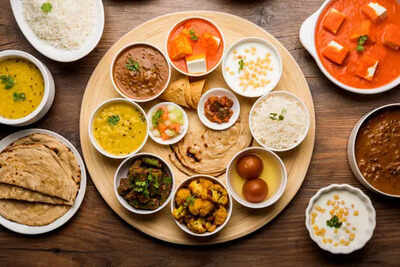Introduction
Explore nine emblematic thalis from across India, each a vibrant reflection of regional heritage, flavors, and tradition—perfect for trivia buffs and food lovers alike.
Rajasthan Thali
This platter is famed for its bold, spicy flavors and liberal use of ghee. Staples include bajra rotis, dal‑baati‑churma, and gatte ki sabzi—robust enough for desert survival. It’s rich, hearty, and emblematic of Marwari royalty. Rajasthan also tops the list with nearly 75% vegetarian population 0.
Assamese Thali
Characterized by light, mustard‑accented dishes that soothe rather than overwhelm. Typical offerings include masor tenga (tangy fish curry), khar (alkaline vegetable preparation), and simple rice accompaniments—a gentle regional fare rooted in Assamese simplicity 1.
Kerala Thali
Known for its coconut and curry‑leaf flavors, often served on banana leaves. It includes rice, fish or vegetable curries, payasam, pachadi, avial, sambar and crispy banana chips—capturing Kerala’s spice and coastal essence 2.
Punjabi Thali
This thali embodies rustic soul food—rich gravies, buttery rotis like makki‑di‑roti, chole, dal makhani, paneer dishes, aamras and sweet lassi. Heavy on dairy and ghee, it’s comfort in every bite 3.
Maharashtrian Thali
Offers tangy and toasted flavors grounded in millet, bhakri, sabudana vada, poha, pitla & thecha, and aamras. It earns its earthy, yet vibrant taste profile from the Konkan coast and interior Maharashtra traditions 4.
Gujarati Thali
Celebrated for its harmonious sweet‑and‑savory balance—dhokla, khaman, undhiyu, thepla, papdi and gur (jaggery)‑based sweets. This vegetarian platter is a festival of flavors in miniature portions 5.
West Bengal Thali
A comforting slow‑cooked spread featuring rice, mustard‑flavored fish and vegetable dishes, dal, and sweets like roshogolla or sandesh. It’s a soulful integration of spice and tradition rooted in Bengali heritage 6.
Tamil Nadu Thali
Built around spices, sambhar and structured meal traditions. Includes rice, sambhar, rasam, various chutneys like coconut and podi, appalam, curd, and possibly Chettinad-style meat or veg curries for festive versions 7.
Uttarakhand (Kumaoni) Thali
Designed for the hill climate, this clean, warming thali often consists of aloo ka jholor (spiced potato stew), bhat (rice), local pulses like bhut ki dal, baadi, phanu, chutney, poori, and seasonal greens—simple but heartening fare 8.
Quiz‑Ready Facts & Trivia
- **States covered**: 9 distinctive regional thalis span north, south, east, west and hill states.
- **Flavor spectrum**: from ghee‑rich Rajasthan to mustard‑light Assam, tropical Kerala and sweet‑savory Gujarat.
- **Cultural symbolism**: Thalis often represent Ayurvedic balance—six tastes (sweet, sour, salty, pungent, bitter, astringent) are present in a single platter.
- **Serving traditions**: Many are served on banana leaves (Kerala, Tamil Nadu, Uttarakhand), while others use metal thalis.
Conclusion
Each thali is more than a meal—it’s a culinary snapshot of a region’s culture, history, and ecology. From Rajasthan’s desert spices to Assam’s mustard notes, Kerala’s coconut richness to Punjab’s dairy opulence—these regional thalis are trivia gold and gastronomic treasures all at once.
Source: The Times Of India

